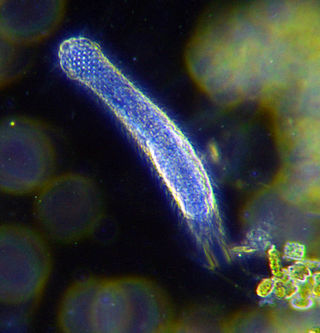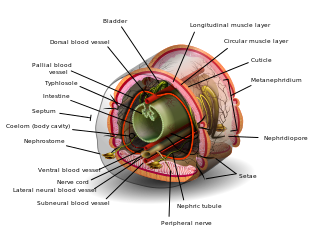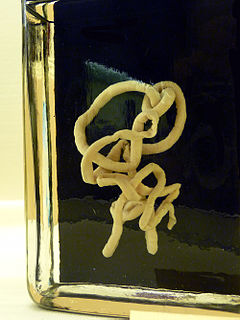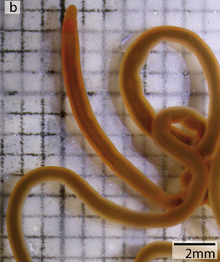
The Sipuncula or Sipunculida is a class containing about 162 species of unsegmented marine annelid worms. The name Sipuncula is from the genus name Sipunculus, and comes from the Latin siphunculus meaning a "small tube".

The gastrotrichs, commonly referred to as hairybellies or hairybacks, are a group of microscopic (0.06-3.0 mm), worm-like, acoelomate animals, and are widely distributed and abundant in freshwater and marine environments. They are mostly benthic and live within the periphyton, the layer of tiny organisms and detritus that is found on the seabed and the beds of other water bodies. The majority live on and between particles of sediment or on other submerged surfaces, but a few species are terrestrial and live on land in the film of water surrounding grains of soil. Gastrotrichs are divided into two orders, the Macrodasyida which are marine, and the Chaetonotida, some of which are marine and some freshwater. Nearly 800 species of gastrotrich have been described.

The Mesozoa are minuscule, worm-like parasites of marine invertebrates. Generally, these tiny, elusive creatures consist of a somatoderm of ciliated cells surrounding one or more reproductive cells. Decades ago, Mesozoa were classified as a phylum. Molecular phylogeny studies, however, have shown that the mysterious mesozoans are polyphyletic.

Nemertea is a phylum of animals also known as ribbon worms or proboscis worms. Most ribbon worms are very slim, usually only a few millimeters wide, although a few have relatively short but wide bodies. Many have patterns of yellow, orange, red and green coloration. The foregut, stomach and intestine run a little below the midline of the body, the anus is at the tip of the tail, and the mouth is under the front. A little above the gut is the rhynchocoel, a cavity which mostly runs above the midline and ends a little short of the rear of the body. All species have a proboscis which lies in the rhynchocoel when inactive but everts to emerge just above the mouth to capture the animal's prey with venom. A highly extensible muscle in the back of the rhynchocoel pulls the proboscis in when an attack ends. A few species with stubby bodies filter feed and have suckers at the front and back ends, with which they attach to a host.

The coelom is the main body cavity in most animals and is positioned inside the body to surround and contain the digestive tract and other organs. In some animals, it is lined with mesothelium. In other animals, such as molluscs, it remains undifferentiated. In the past, and for practical purposes, coelom characteristics have been used to classify bilaterian animal phyla into informal groups.

Amiskwia is a genus of soft-bodied animals known from fossils of the Middle Cambrian Lagerstätten both in the Burgess Shale in British Columbia, Canada and the Maotianshan shales of Yunnan Province, China. It is interpreted as a member of the clade Gnathifera sensu lato.

Trematoda is a class of flatworms known as flukes. They are obligate internal parasites with a complex life cycle requiring at least two hosts. The intermediate host, in which asexual reproduction occurs, is usually a snail. The definitive host, where the flukes sexually reproduce, is a vertebrate. Infection by trematodes can cause disease in many types of vertebrates, including mammals, birds, reptiles, and fish.

Oligochaeta is a subclass of animals in the phylum Annelida, which is made up of many types of aquatic and terrestrial worms, including all of the various earthworms. Specifically, oligochaetes comprise the terrestrial megadrile earthworms, and freshwater or semiterrestrial microdrile forms, including the tubificids, pot worms and ice worms (Enchytraeidae), blackworms (Lumbriculidae) and several interstitial marine worms.
A hydrostatic skeleton, or hydroskeleton, is a flexible skeleton supported by fluid pressure. Hydrostatic skeletons are common among simple invertebrate organisms. While more advanced organisms can be considered hydrostatic, they are sometimes referred to as hydrostatic for their possession of a hydrostatic organ instead of a hydrostatic skeleton. A hydrostatic organ and a hydrostatic skeleton may have the same capabilities, but they are not the same. Hydrostatic organs are more common in advanced organisms, while hydrostatic skeletons are more common in primitive organisms. As its name suggests, containing hydro meaning "water", being hydrostatic means that the skeleton or organ is fluid-filled.

The Turbellaria are one of the traditional sub-divisions of the phylum Platyhelminthes (flatworms), and include all the sub-groups that are not exclusively parasitic. There are about 4,500 species, which range from 1 mm (0.039 in) to large freshwater forms more than 500 mm (20 in) long or terrestrial species like Bipalium kewense which can reach 600 mm (24 in) in length. All the larger forms are flat with ribbon-like or leaf-like shapes, since their lack of respiratory and circulatory systems means that they have to rely on diffusion for internal transport of metabolites. However, many of the smaller forms are round in cross section. Most are predators, and all live in water or in moist terrestrial environments. Most forms reproduce sexually and with few exceptions all are simultaneous hermaphrodites.

Anopla has long been used as name for a class of marine worms of the phylum Nemertea, characterized by the absence of stylets on the proboscis, the mouth being below or behind the brain, and by having separate openings for the mouth and proboscis. The other long used class of Nemertea are the Enopla. Although Anopla is a paraphyletic grouping, it is used in almost all Scientific classifications. Anopla is divided into two orders: Palaeonemertea and Heteronemertea.

Heteronemertea is a monophyletic order of about 500 species of nemertean worm. It contains genera such as Lineus and Cerebratulus, and includes the largest and most muscular nemerteans.

Haplodrili, or Archiannelida, is an order of primitive polychaete worms. Zoologist Ray Lankester gave it the name haplodrili, while zoologist Berthold Hatschek later named it Archiannelida. Once considered to be a class under Annelida, and even a separate phylum, Haplodrili is now widely accepted to be an order under Polychaeta. Species in this order are known for completely lacking external segments.

Enopla is one of the classes of the worm phylum Nemertea, characterized by the presence of a peculiar armature of spines or plates in the proboscis.

Geoplanidae is a family of flatworms known commonly as land planarians or land flatworms.

An earthworm is a terrestrial invertebrate that belongs to the phylum Annelida. They exhibit a tube-within-a-tube body plan; they are externally segmented with corresponding internal segmentation; and they usually have setae on all segments. They occur worldwide where soil, water, and temperature allow.

Lineidae is a family of nemertean worms. It contains the following genera:

Malacobdellidae is a monogeneric family within the phylum Nemertea. It is included with the order Hoplonemertea within the class Enopla.

The annelids, also known as the segmented worms, are a large phylum, with over 22,000 extant species including ragworms, earthworms, and leeches. The species exist in and have adapted to various ecologies – some in marine environments as distinct as tidal zones and hydrothermal vents, others in fresh water, and yet others in moist terrestrial environments.

Tubulanidae is a family of primitive nemertean worms in the order Palaeonemertea.



















